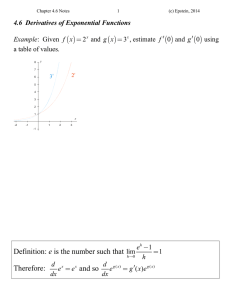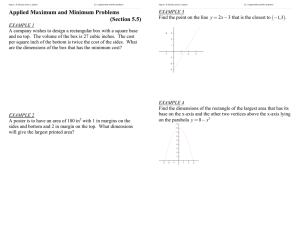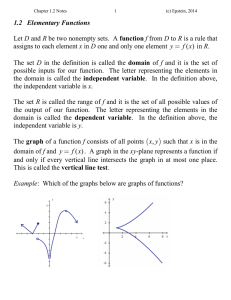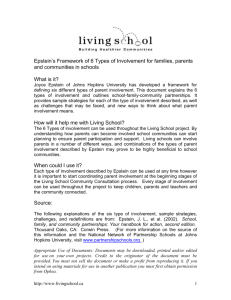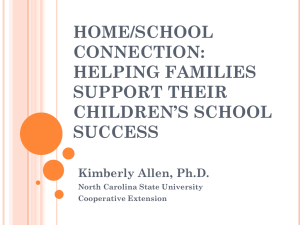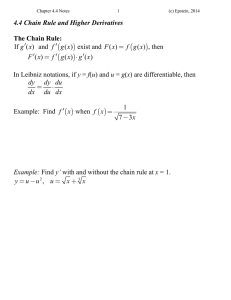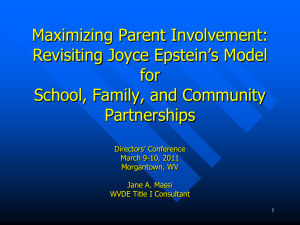Parent Involvement Framework: Epstein's 6 Types
advertisement
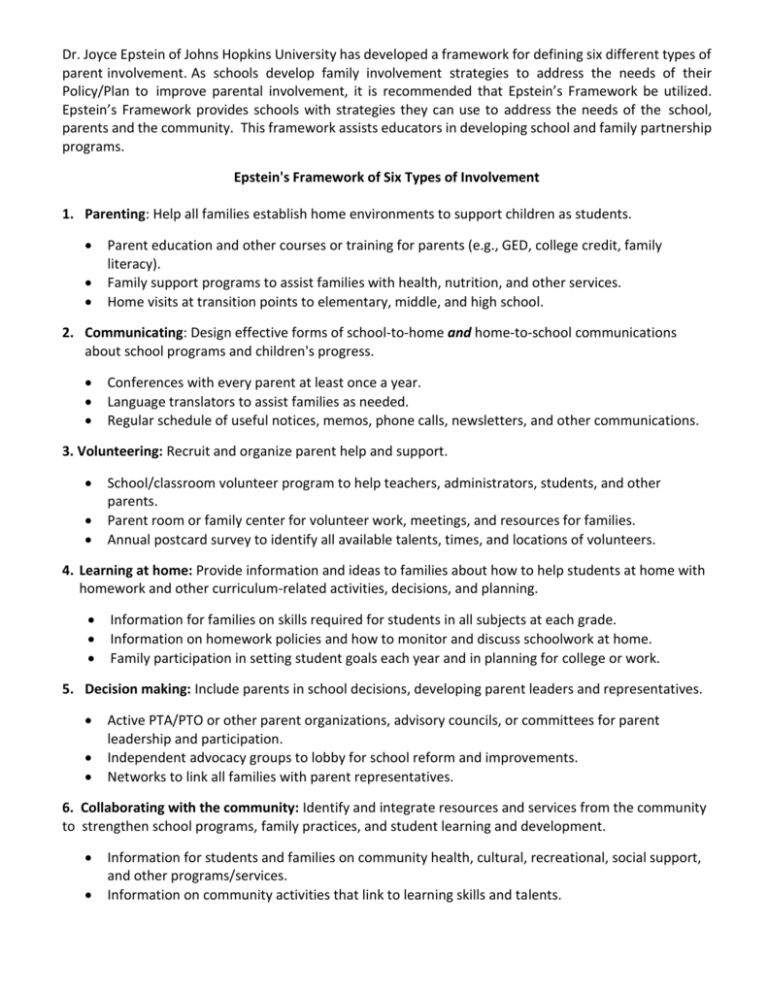
Dr. Joyce Epstein of Johns Hopkins University has developed a framework for defining six different types of parent involvement. As schools develop family involvement strategies to address the needs of their Policy/Plan to improve parental involvement, it is recommended that Epstein’s Framework be utilized. Epstein’s Framework provides schools with strategies they can use to address the needs of the school, parents and the community. This framework assists educators in developing school and family partnership programs. Epstein's Framework of Six Types of Involvement 1. Parenting: Help all families establish home environments to support children as students. Parent education and other courses or training for parents (e.g., GED, college credit, family literacy). Family support programs to assist families with health, nutrition, and other services. Home visits at transition points to elementary, middle, and high school. 2. Communicating: Design effective forms of school-to-home and home-to-school communications about school programs and children's progress. Conferences with every parent at least once a year. Language translators to assist families as needed. Regular schedule of useful notices, memos, phone calls, newsletters, and other communications. 3. Volunteering: Recruit and organize parent help and support. School/classroom volunteer program to help teachers, administrators, students, and other parents. Parent room or family center for volunteer work, meetings, and resources for families. Annual postcard survey to identify all available talents, times, and locations of volunteers. 4. Learning at home: Provide information and ideas to families about how to help students at home with homework and other curriculum-related activities, decisions, and planning. Information for families on skills required for students in all subjects at each grade. Information on homework policies and how to monitor and discuss schoolwork at home. Family participation in setting student goals each year and in planning for college or work. 5. Decision making: Include parents in school decisions, developing parent leaders and representatives. Active PTA/PTO or other parent organizations, advisory councils, or committees for parent leadership and participation. Independent advocacy groups to lobby for school reform and improvements. Networks to link all families with parent representatives. 6. Collaborating with the community: Identify and integrate resources and services from the community to strengthen school programs, family practices, and student learning and development. Information for students and families on community health, cultural, recreational, social support, and other programs/services. Information on community activities that link to learning skills and talents. Barriers and Solutions to Parent Involvement in Schools Schools can identify potential barriers and work together to overcome them so that positive family involvement programs can continue to develop and grow in schools. Potential Barriers Possible Solutions (Strategies) Lack of time Plan events around parents’ schedules Partner with organizations that provide service to parents such as churches and community organizations (example Beacon Center) Economic constraints Provide snacks, meals, transportation, and childcare Lack of transportation Offer transportation with information on bus schedules Lack of childcare Provide onsite childcare Language communication barriers Cultural Sensitivity Communicate with parents via multiple methods: print, phone calls home, home visits, agencies serving parents, and multicultural radio programs Develop materials that are parent friendly and provide translated documents for the school’s diverse population Train staff in the diverse cultural practices of school’s families Provide translators for meetings and trainings and provide translated documents for the school’s diverse population Conflicting work schedules Conduct a needs assessment of times and dates parents are available; include AM, PM, and Saturdays Anxiety about child’s performance Encourage and support home involvement that empowers parents with tools to support home activities effectively. Address parents’ expectations of their child’s education Lack of family buy-in of schoolwide programming Ensure that families are brought into the decision-making process regarding family involvement initiatives Ensure that school staff has a shared vision of family involvement Increase and vary methods of communication to reach all parents Use data that supports the needs of parents Call upon parent leaders to act in family involvement leadership roles to recruit other parents Have an active parent liaison and family involvement committee to reach out to parents and assist them Empower parents as decision makers and train them as leaders Strategies Linked to Student Achievement This chart is a tool to provide schools with quality family involvement strategies that are linked to student achievement. Traditional Activity Modification Correlation to Student Achievement for the School Policy/Plan Open House: Parents rotate through classes to meet their child’s teacher Each teacher provides expectations of student achievement; what students need to know and be able to do. Teachers will provide parents activities to help their children at home. Provide information to parents on expectations and how parents can help their children. Reading Night (Mathematics Night, Science Night, etc.) Teachers demonstrate the specific skills and strategies which will be taught. Provide information to parents on the how and when students will be assessed and how parents can help. Provide information to parents on expectations and strategies, handouts and resources on how parents can help their children. PTA/PTO Meetings SAC Meetings Provide parent leadership training Increase the level of involvement of parents to become active in the decisions made at the school. Contact parents via automated phone system Notify parents about school functions, when students are absent, tardy, suspended, etc. Increase communication with parents; provide updates on school functions in multiple languages Publish monthly newsletters Provide specific strategies for parents to use to help their children with the skills being taught in the current month. Offering various topics and levels of parenting classes Provide specific information to parents such as how to get into college, Internet safety, reading/mathematics/ science/writing; (add specific content in areas needed by your parents) Provide information to parents on expectations and how parents can help their children. Provide information of what activities parents can be involved in at school. Provide information and workshops to parents on how parents can help their children. Send home parent reports on test results or meeting to distribute report cards Conduct student led conferences where students explain their own test results to their parents (with teacher support) Provide information on their child’s current level and develop a plan to reach their goals. College Night Provide sessions with parents to help them complete financial aid documents, search for scholarships, etc. Increase student participation in post-secondary programs. Publish information on Next Generation Standards and/or Common Core Standards Provide information on the specific skills students need. Add strategies that show parents how they can help at home. Provide information and strategies to parents on how to help their children with all subjects Multicultural Events Tie the content of the program to the social studies curriculum and the specific standards addressed Provide information to parents on the content of standards and provide resources and materials to support the event Training for staff during faculty meetings on parental involvement Provide grade and subject specific training for teachers on how to explain the NGSSS and/or Common Core Standards to parents Improve the ability of staff to work effectively with parents.
